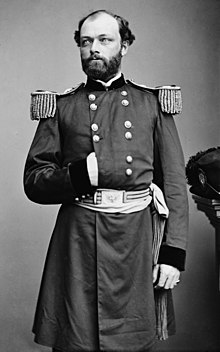Quincy Gillmore
| Quincy Adams Gillmore | |
|---|---|

Civil War–era portrait of Gillmore.
|
|
| Born |
February 25, 1825 Black River (now Lorain), Ohio |
| Died | April 11, 1888 (aged 63) Brooklyn, New York |
| Allegiance |
United States of America Union |
| Service/branch |
United States Army Union Army |
| Years of service | 1849–1865 |
| Rank |
|
| Commands held | X Corps |
| Battles/wars | |
| Awards | Gillmore Medal |
Quincy Adams Gillmore (February 25, 1825 – April 11, 1888) was an American civil engineer, author, and a general in the Union Army during the American Civil War. He was noted for his actions in the Union victory at Fort Pulaski, where his modern rifled artillery readily pounded the fort's exterior stone walls, an action that essentially rendered stone fortifications obsolete. He earned an international reputation as an organizer of siege operations and helped revolutionize the use of naval gunnery.
Gillmore was born and raised in Black River (now the City of Lorain) in Lorain County, Ohio. He was named after the president-elect at the time of his birth, John Quincy Adams.
He entered the United States Military Academy at West Point, New York, in 1845. He graduated in 1849, first in a class of 43 members. He was appointed to the engineers and was promoted to first lieutenant in 1856. From 1849 until 1852, he was engaged in constructing the fortifications at Hampton Roads in coastal Virginia. For the next four years, he was instructor of Practical Military Engineering at West Point and designed a new riding school.
Beginning in 1856, Gillmore served as a purchasing agent for the Army in New York City. He was promoted to captain in 1861.
With the outbreak of the Civil War in early 1861, Gillmore was assigned to the staff of Brig. Gen.Thomas W. Sherman and accompanied him to Port Royal, South Carolina. After being appointed as a brigadier general, Gillmore took charge of the siege operations against Fort Pulaski. A staunch advocate of the relatively new naval rifled guns, he was the first officer to effectively use them to knock out an enemy stone fortification. More than 5,000 artillery shells fell on Pulaski from a range of 1,700 yards during the short siege, which resulted in the fort's surrender after its walls were breached.
...
Wikipedia
